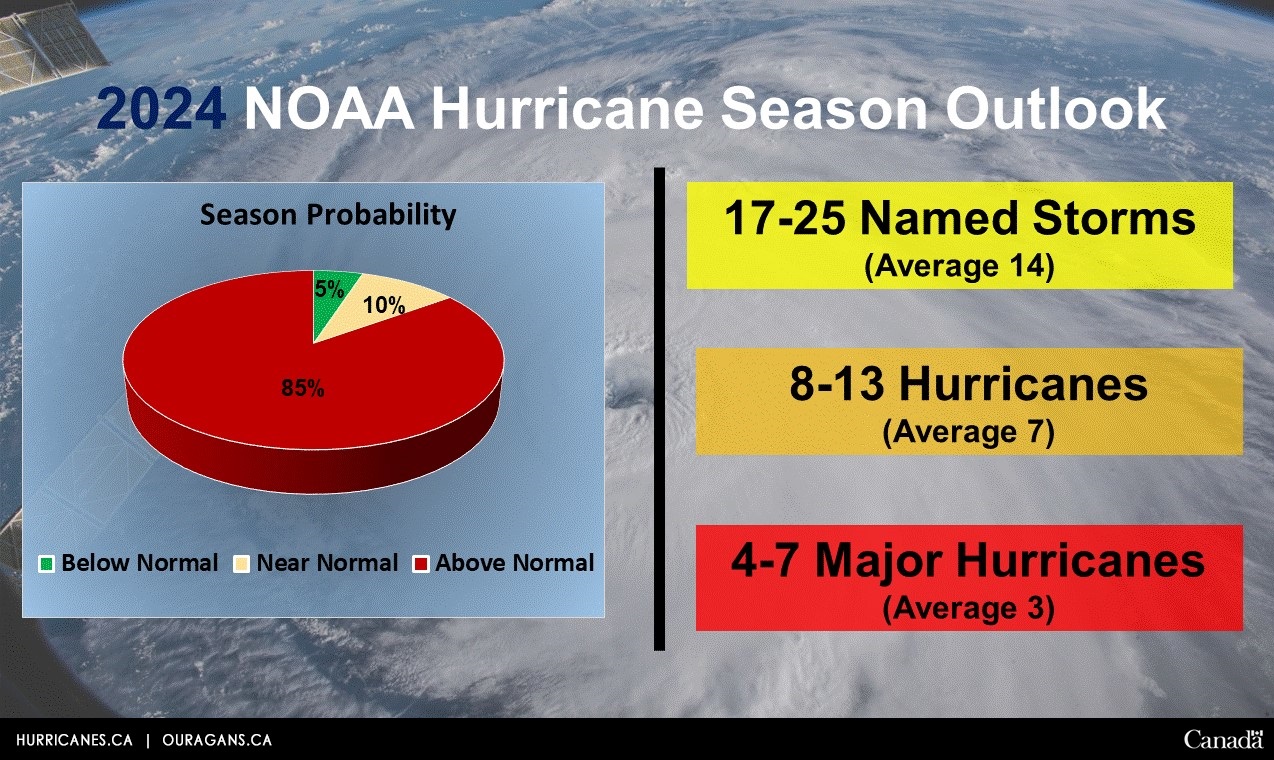**** Via ECCC Canadian Hurricane Centre
Very warm water in the tropical Atlantic and a developing La Nina are expected to contribute to a very active hurricane season.

NOAA in the U.S. released their outlook for the season. About 35% of Atlantic tropical cyclones on average enter the @ECCC_CHC response zone.

**** Info via Environment Canada
What to do when a Hurricane Watch or Warning is issued
Hurricanes can often be predicted one or two days in advance of their landfall. The key to hurricane protection is preparation. By taking precautions before, during, and after a hurricane, lives can be saved and property damage averted.
It is important to stay informed by listening to the latest warnings and advisories on radio, television, or web sites. The Canadian Hurricane Centre will issue and update these when necessary.
- If a hurricane is forecast, secure everything that might be blown around or torn loose. Flying objects such as garbage cans and lawn furniture can injure people and damage property.
- Trim dead branches and cut down dead trees to reduce the danger of these falling onto your house during a storm.
- Stock up on water, ready-to-eat food and heating fuel, as well as battery-powered or wind-up flashlights and radios – and extra batteries. Make sure that there is gasoline in the car. For a complete list of emergency supplies, go to emergency kits. Also, learn what to have in your car emergency kit.
If you live on the coast or in a low-lying area near the coast, be prepared to move inland and to higher ground if instructed by local officials. The high winds can create large waves at sea which may become storm surges when they reach the shore. If you are advised by officials to evacuate, do so. Take your emergency kit with you.
During a hurricane
- Always check the marine forecast from the Weatheroffice website before going boating and listen to weather reports during your cruise. Never go out in a boat during a storm. If you are on the water and you see bad weather approaching, head for shore immediately.
- Do not go down to the water to watch the storm. Most people who are killed during hurricanes are caught in large waves, storm surges or flood waters.
- If the eye of the hurricane passes over, there will be a lull in the wind lasting from two or three minutes to half an hour. Stay in a safe place. Make emergency repairs only and remember that once the eye has passed over, the winds will return from the opposite direction with possibly even greater force.
- Listen for reports from authorities on your portable radio.
- If lightning is present, remember that you can use a cellular telephone during a severe storm, but it’s not safe to use a land-line telephone.
- On a farm, depending on your location and available shelter, it may be better to leave livestock unsheltered. During Hurricane Andrew, some horses left outside suffered less injury then those placed in shelters. This was because some shelters did not withstand the high winds. Horses were injured by collapsing structures and flying objects that may have been avoided on the outside. For more information, view our publication Emergency Preparedness for Farm Animals.
Mobile homes
If you live in a mobile home:
- Position your mobile home near a natural windbreak such as a hill or clump of trees.
- Anchor the structure securely. Consult the manufacturer for information on secure tie-down systems.
- When a severe storm approaches, seek shelter in a more secure building as staying in a mobile home during a hurricane can be more dangerous than going outside.
–
**** NS SPCA Release (By Judy Layne)
Keep Your Pets Safe in an Emergency: 8 Things You Need to Know

Emergencies come in many forms – floods, fires and hurricanes to name just a few. This year, severe flooding swept across Eastern Canada with devastating and deadly effects. In 2016, wildfires in Fort McMurray left a shattering path of destruction in their wake and forced 88,000 families to evacuate their homes. Think it can’t happen to you? Think again.
Because disaster can strike with little warning and limited time to prepare, it’s important to think NOW about what you can do to ensure the safety of your pets in the event of an emergency. Remember that pets are family and depend on us for protection!
Here are 8 important things you can do to keep your pets safe.
- Develop a plan. Plan where you and your pets will stay if you need to evacuate your home. Some disaster centers don’t accept pets, so make plans ahead of time to take your pets to a friend’s/relative‘s home , pet-friendly hotel, shelter or kennel outside of the evacuation area.
- Make a kit. Pets need certain critical supplies during an emergency. The national Centre for Disease Control (CDC) has developed a great checklist to help you ensure you take essential things with you. See the checklist here!
- Ensure vaccinations are current. Most kennels require proof of current rabies and distemper shots. Keep these papers with other important documents you would carry if you need to evacuate.
- Microchip your pets. In case your pets get lost, this can be the difference between lost pets coming home or not. Ensure their microchips are registered and your contact information is current.
- Buy a carrier for each of your pets. Include blankets and towels for bedding/warmth and a favorite toy to reduce stress.Write your pet’s name, your name and contact information on each carrier. Familiarize your pets with their carriers over time.
- Practice evacuating with your pets. Know where your pets might hide when scared or stressed. Practice removing them from their hiding spot and into their carriers, so you can get them quickly out of harm’s way.
- Never leave pets behind. In severe weather, bring your pets inside immediately. Never leave pets chained outside during a storm. If you must evacuate, take your pets with you.
- Be cautious when you return home. Familiar scents/landmarks may have changed after an emergency and pets can become confused and lost. It’s important to keep your pets on a leash for a few days when you go outside. Check your home and yard for downed power lines, sharp objects, spilled chemicals or contaminated water that could harm your pets.
Too many beloved pets have been injured or worse during emergencies. Don’t wait until it’s too late. Don’t let your pet become another statistic.
Judy Layne
Judy is a dedicated volunteer with the Nova Scotia SPCA and proud adoptive fur-mama to Gracie. She is committed to speaking for animals who cannot speak for themselves
–
**** Via Canada.ca
Get an emergency kit!
Assemble one…
–
**** Info via REMO Kings Cty
Plan for evacuations
The best way to protect your pet in an emergency is to bring it with you. Most evacuation shelters will only accept service animals. Make a list of where your pet can be taken in case you need to evacuate. This list can include:
🐶Hotels that accept animals even during emergencies
🐱Boarding centres and animal shelters
🐶Animal clinics
🐱Family members and friends
Include your pet in your family emergency plan exercises.





